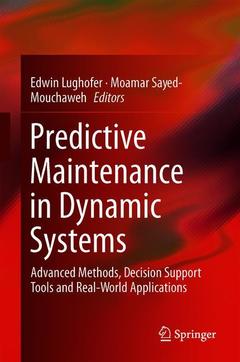Description
Predictive Maintenance in Dynamic Systems, 1st ed. 2019
Advanced Methods, Decision Support Tools and Real-World Applications
Language: English
Subject for Predictive Maintenance in Dynamic Systems:
Publication date: 03-2019
567 p. · 15.5x23.5 cm · Hardback
567 p. · 15.5x23.5 cm · Hardback
Description
/li>Contents
/li>Biography
/li>Comment
/li>
This book provides a complete picture of several decision support tools for predictive maintenance. These include embedding early anomaly/fault detection, diagnosis and reasoning, remaining useful life prediction (fault prognostics), quality prediction and self-reaction, as well as optimization, control and self-healing techniques. It shows recent applications of these techniques within various types of industrial (production/utilities/equipment/plants/smart devices, etc.) systems addressing several challenges in Industry 4.0 and different tasks dealing with Big Data Streams, Internet of Things, specific infrastructures and tools, high system dynamics and non-stationary environments . Applications discussed include production and manufacturing systems, renewable energy production and management, maritime systems, power plants and turbines, conditioning systems, compressor valves, induction motors, flight simulators, railway infrastructures, mobile robots, cyber security and Internet ofThings. The contributors go beyond state of the art by placing a specific focus on dynamic systems, where it is of utmost importance to update system and maintenance models on the fly to maintain their predictive power.
Introduction.- Predictive Maintenance and (Early) FDD in Dynamic Systems.- Beyond State-of-the-Art.- Early Fault Detection and Diagnosis Approaches.- Prognostics and Forecasting.- Self-Reaction and Self-Healing Techniques.- Applications of Predictive Maintenance with emphasize on Industry 4.0 challenges.- Conclusion.
Edwin Lughofer received his PhD-degree from the Johannes Kepler University Linz (JKU) in 2005. He is currently Key Researcher with the Fuzzy Logic Laboratorium Linz / Department of Knowledge-Based Mathematical Systems (JKU) in the Softwarepark Hagenberg. He has participated in several basic and applied research projects on European and national level, with a specific focus on topics of Industry 4.0 and FoF (Factories of the Future). He has published around 200 publications in the fields of evolving fuzzy systems, machine learning and vision, data stream mining, chemometrics, active learning, classification and clustering, fault detection and diagnosis, quality control and predictive maintenance, including 80 journals papers in SCI-expanded impact journals, a monograph on ’Evolving Fuzzy Systems’ (Springer) and an edited book on ’Learning in Non-stationary Environments’ (Springer). In sum, his publications received 4200 references achieving an h-index of 36. He is associate editor of the international journals Information Sciences, IEEE Transactions on Fuzzy Systems, Evolving Systems, Information Fusion, Soft Computing and Complex and Intelligent Systems, the general chair of the IEEE Conference on EAIS 2014 in Linz, the publication chair of IEEE EAIS 2015, 2016, 2017 and 2018, the program co-chair of the International Conference on Machine Learning and Applications (ICMLA) 2018, the tutorial chair of IEEE SSCI Conference 2018, the publication chair of the 3rd INNS Conference on Big Data and Deep Learning 2018, and the Area chair of the FUZZ-IEEE 2015 conference in Istanbul. He co-organized around 12 special issues and more than 20 special sessions in international journals and conferences. In 2006 he received the best paper award at the International Symposium on Evolving Fuzzy Systems, in 2013 the best paper award at the IFAC conference in Manufacturing Modeling, Management and Control (800 participants) and in 2016 the be
Covers recent developments in predictive maintenance, including basic algorithms and methods, required notions, and definitions Discusses problems in application domains such as on-line production lines, factories of the future, , IoT, power plants and turbines, conditioning systems, railway infrastructures, equipment and tool monitoring, and energy facilities Studies the links between methods and techniques as well as open challenges of predictive maintenance, addresses early fault detection, prognostics and diagnosis, and optimization and self–healing techniques for on-line decision support tools in dynamic systems
© 2024 LAVOISIER S.A.S.



